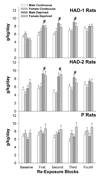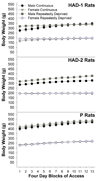Effects of short deprivation and re-exposure intervals on the ethanol drinking behavior of selectively bred high alcohol-consuming rats
- PMID: 18486429
- PMCID: PMC2600571
- DOI: 10.1016/j.alcohol.2008.03.130
Effects of short deprivation and re-exposure intervals on the ethanol drinking behavior of selectively bred high alcohol-consuming rats
Abstract
Alcoholics generally display cycles of excessive ethanol intake, abstinence and relapse behavior. Using an animal model of relapse-like drinking, the alcohol deprivation effect (ADE), our laboratory has shown that repeated 2-week cycles of ethanol deprivation and re-exposure, following an initial 6-week access period, result in a robust ADE by alcohol-preferring (P) and high alcohol-drinking (HAD-1 and HAD-2) rats. These rat lines have been selectively bred to prefer a 10% ethanol solution over water. The present study examined whether P and HAD rats would display an ADE using much shorter ethanol deprivation and re-exposure intervals. Rats were given either continuous or periodic concurrent access to multiple concentrations (10%, 20%, and 30% [vol/vol]) of ethanol. The periodic protocol involved access to ethanol for 12 days followed by four cycles of 4 days of deprivation and 4 days of re-exposure to ethanol access. High-alcohol-drinking rats displayed a robust 24-h ADE upon first re-exposure (HAD-1: approximately 5 vs. 8g/kg/day; HAD-2: approximately 6 vs. 9g/kg/day, baseline vs. re-exposure), whereas P rats ( approximately 7 vs. 8g/kg/day) displayed a modest, nonsignificant, increase in 24-h intake. In a separate group of rats, ethanol intake and blood alcohol concentrations after the first hour of the fourth re-exposure cycle were HAD-1: 2.0g/kg and 97 mg%, HAD-2: 2.3g/kg and 73 mg%, and P: 1.2g/kg and 71 mg%; with all three lines displaying a robust first hour ADE. These findings suggest that (a) an ADE may be observed with short ethanol deprivation and re-exposure intervals in HAD rats, and (b) the genetic make-up of the P and HAD rats influences the expression of this ADE.
Figures




References
-
- Adams N. Sex differences and the effects of tail pinch on ethanol drinking in Maudsley rats. Alcohol. 1995;12:463–468. - PubMed
-
- Agabio R, Carai MA, Lobina C, Pani M, Reali R, Vacca G, Gessa GL, Colombo G. Development of short-lasting alcohol deprivation effect (ADE) in Sardinian alcohol-preferring rats. Alcohol. 2000;21:59–62. - PubMed
-
- Barrick C, Connors GJ. Relapse prevention and maintaining abstinence in older adults with alcohol-use disorders. Drugs Aging. 2002;19:583–594. - PubMed
-
- Bell RL, McKinzie DL, Murphy JM, McBride WJ. Sensitivity and tolerance to the motor impairing effects of moderate doses of ethanol. Pharmacol. Biochem. Behav. 2000;67:583–586. - PubMed
-
- Bell RL, Rodd ZA, Boutwell CL, Hsu CC, Lumeng L, Murphy JM, Li T-K, McBride WJ. Effects of long-term episodic access to ethanol on the expression of an alcohol deprivation effect in low alcohol-consuming rats. Alcohol. Clin. Exp. Res. 2004a;28:1867–1874. - PubMed
Publication types
MeSH terms
Substances
Grants and funding
LinkOut - more resources
Full Text Sources
Medical

